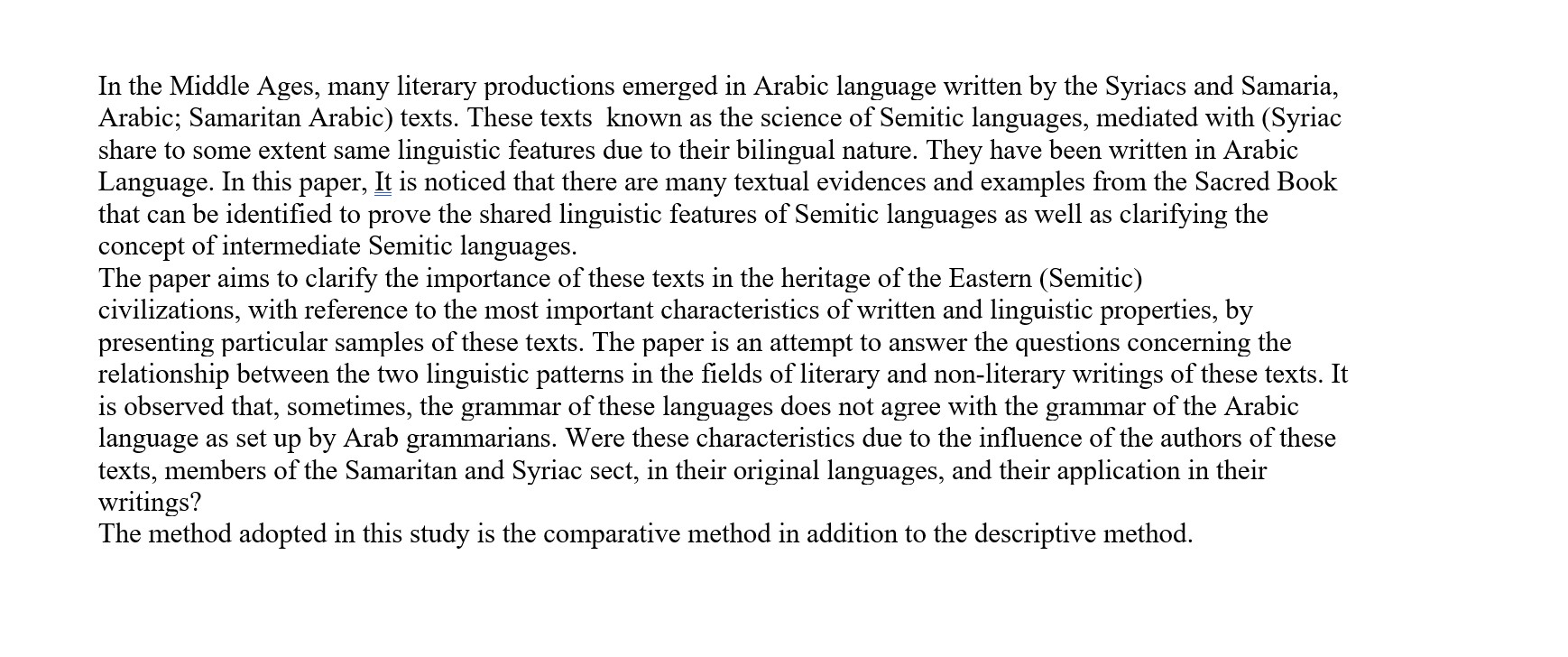A comparative study of the features in Syriac Arabic and Samaritan Arabic, exploring their similarities and differences as Semitic languages
DOI:
https://doi.org/10.21271/zjhs.27.s6.4Keywords:
Semitic languages, Middle Arabic Syriac, Samaria, scrollsAbstract
In the Middle Ages, many literary productions emerged in Arabic language written by the Syriacs and Samaria, known as the science of Semitic languages, mediated with (Syriac Arabic; Samaritan Arabic) texts. These texts share to some extent same linguistic features due to their bilingual nature. They have been written in Arabic Language. In this paper, It is noticed that there are many textual evidences and examples from the Sacred Book that can be identified to prove the shared linguistic features of Semitic languages as well as clarifying the concept of intermediate Semitic languages.
The paper aims to clarify the importance of these texts in the heritage of the Eastern (Semitic) civilizations, with reference to the most important characteristics of written and linguistic properties, by presenting particular samples of these texts. The paper is an attempt to answer the questions concerning the relationship between the two linguistic patterns in the fields of literary and non-literary writings of these texts. It is observed that, sometimes, the grammar of these languages does not agree with the grammar of the Arabic language as set up by Arab grammarians. Were these characteristics due to the influence of the authors of these texts, members of the Samaritan and Syriac sect, in their original languages, and their application in their writings?
The method adopted in this study is the comparative method in addition to the descriptive method.
References
- حجي، نهاد حسن، (2013)، مقدمة في دراسة اللغة العبريّة السامريّة، مجلة لارك للفلسفة واللسانيات والعلوم الاجتماعية، العراق، مجلد 1 عدد 11.
- الابرشي، محمد عطية (1946)، الآداب السامية، ط1، دار احياء الكتب العربية.
- التوبنجي، محمد،(1986)، لمنهاج في تأليف البحوث و تحقيق المخطوطات، دار عالم الكتب، حلب.
- السامرائي، ابراهيم، (1985)، دراسات في اللغتين السريانية والعربية، ط1، دار الجيل، بيروت.
- السامرائي، قاسم، (1987)، كتاب الاعتبار، طبعة الرياض.
- الشمري، نهاد حسن حجي، دراسة في الصفات اللغوية للأسفار الخمسة السامرية في ضوء علم اللغات السامية المقارنة مجلة النجاح للعلوم الإنسانية نابلس فلسطين، 2023.
- الصوري، الحسن ، (1978) ترجمة التوراة السامرية، اعداد الكاهن عبد المعين صدقة، نابلس.
- الطباع، اياد خالد،(2003)، منهج تحقيق المخطوطات ومعه كتاب شوق المستهام في معرفة رموز الاقلام لابن وحشة النبطي، دمشق.
- الطعان، هاشم، (1978)، مساهمة العرب في دراسة اللغات السامية، بغداد.
- النوري، محمد جواد، (1979)، الاصوات في اللهجات الشامية (النابلسية).
- جدامي، عبد المنعم السيد احمد، (د. ت)، مفهوم العربية الوسيطة عند المستشرقين الباحثين في تاريخ اللغة العربية، دار النشر.
- حتي، فيليب، (د. ت)، تاريخ سورية ولبنان وفلسطين، ترجمة جورج حداد واخرون، دار الثقافة، بيروت.
- راشد، سيد فرج، (د. ت)، اليهود والسّامرة، مصر.
- شحادة، حسيب، محور: دراسات وابحاث في التاريخ والتراث واللغات، نافذة على السامريين الحوار المتمدن-العدد: 3516 - 2011 / 10 / 14 - 22:13
- عبده سمير، (1997)، السريان قديما وحديثا، ط1، دار الشروق.
- عبده، سمير، (2002)، السريانية العربية الجذور والامتداد، دمشق.
- علي، فؤاد حسنين، (د. ت)، التوراة الهيروغليفية، القاهرة.
- مصطفى الشهابي، (١٩٣٢)، مجلة المجمع العلمي العربي - تعليق مجلد ١٢ سنة.
- هارون، عبدالسلام محمد، البيان والتبيين للجاحظ،(د.ت) ج1، مصر.
- يعقوب اغناطيوس، (1969)، البراهين الحسية على تقارض السريانية والعربية، دمشق.
أ- المصادر العربية:
-عبد اللطيف، محمد، (1979)، من خصائص عربية اليهود في القرن العاشر، جامعة بغداد كلية الآداب لعدد/25.
ب- المصادر العبرية:
- בן חיים، זאב, (1957), עברית וארמית נוסח שומרון. כרך ראשון: מבוא، כתבי הדקדוק. ירושלים תשי"ז.
ج- المصادر الاجنبية:
- Aldalboohi, Nihad Hasan, (2014), Kitab at-Tawtiya de Abu Ishaq Ibrahim B. Faray B. Marut As-Samiri: introduction, study and edition, University of Granada. Semitic Studies Department.
- Blau J, (1966), A grammar of Christian Arabic, based mainly on South-Palestinian texts from the first millennium, 3 vols. Louvain: Secrétariat Dumbarton Corpus.
- Blau J, (1965), The Emergence and Linguistic Background of, judaeo-Arabic: A study of the Origins of Middle Arabic, London: Oxford University press.
- Gallego, María Á, (2006), El Judeo-árabe medieval, Edición, traducción y estudio lingüístico del Kitāb al-taswi'a de Yonah ibn Ğanāḥ, Bern.
- Kippenberg, Hans, (1971), Garizim und Synagoge; Traditionsgeschichte Untersuchungenz. samaritan Religion d. aramäischen Periode, Berlin-New York: Gruyter.
- Macuch, R, (1989), «Samaritan languages: Samaritan Hebrew, Samaritan Aramaic», (ed.), by Grown, Alan D, et al. Mohr Tübingen.
- Martínez Delgado, (2010), Šĕlomo ben Mobarak ben Ṣaʽīr, Kitāb at-Taysīr el libro de la Facilitación (Diccionario de Hebreo Bíblico en Judeoárabe), Granada.
- Nicholl, George, (1853), A grammar of the Samaritan language, with extracts and vocabulary, London: Cambridge.
- Badillos, Sáenz, (1988), Historia De La Lengua Hebrea, Published by AUSA,.
- Šḥada, Ḥ., (1989), «The Arabic Translation of the Samaritan Pentateuch», (ed.), by Crown, Alan D, et al. Mohr Tübingen.
- Stenhouse, P., (1989), «Samaritan Arabic», (ed.), Crown, Alan D, et al Tübingen: Mohr.
- Graf, Georg, (1905), Der Sprachgebrauch der ältesten Christlich-Arabischenn literatur : ein beitrag zur geschichte des vulgär-Arabische.
- Encyclopedia Judaica: 17:
- https://egymonuments.gov.eg/monuments/the-library-of-saint-catherine-s-monastery.

Downloads
Published
Issue
Section
License
Copyright (c) 2023 Hashim Taha Raheem , Nihad Hasan Haji

This work is licensed under a Creative Commons Attribution 4.0 International License.









